Cameras from the 50s and 60s
Photography was a popular hobby in the 50s and 60s. Many people owned a basic camera, often a box Brownie, made by Kodak with which they would take snaps of their holidays and of family events. The basic snapshot camera evolved through the 50s and 60s. Kodak was a pioneer. Their Instamatic introduced in the early sixties freed people from fiddling with the roll film that had been the common format for the snapshot market.
At a more advanced level the 35mm film became the first choice for professionals and serious amateurs. The Japanese SLR camera almost completely took over the professional market by the end of the 60s. Many keen amateurs were moving from prints to 35mm slides in the 60s. The slide show became a popular after dinner party entertainment. Another technological innovation was taking the popular market by storm at the end of the sixties - instant cameras. The Polariod Swinger became a symbol of the decade.
Kodak Brownie cameras
Brownie '127' - 50s
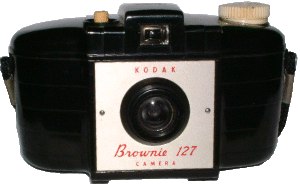
Remember the Brownie '127'? This is the camera that everyone's Mum had. It took '127' roll film backed with yellow paper. This model is the first version. It was made between 1952 and 1959. Kodak changed the style of these cameras regularly to keep up with current fashion. This model was restyled in 1959 and again in 1963.
Kodak Cresta 3 - 60s
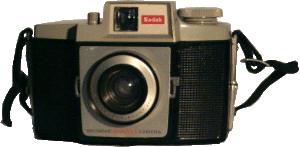
Kodak produced several variants on the same theme. This camera (right) is the Cresta 3. This was slightly, and I mean slightly, more advanced than the Brownie 127. It had a close-up lens and provision for a flash attachment.
It is a later model from the sixties, rather than the fifties. You can see the more modern styling applied to a basically similar product. This camera used the larger 120 roll film instead of 127. Both cameras can take quite adequate colour pictures if you are aware of their limitations - used outdoors in reasonably bright conditions, with the subject not too close.
Colour photography
Colour photography had been around before the War, but it was considered the realm of the expert photographer. Most amateurs only used black and white film. In the fifties and increasingly in the sixties, colour photography was becoming more and more popular for snapshots, as well as for serious work.
In the sixties, the most popular form of colour photography was colour slides. You needed a projector and/or a slide viewer. The 35mm format was also becoming more popular. Originally, it had been for movie work. Hence the holes cut along the sides of the film.
Kodak Colorsnap 35
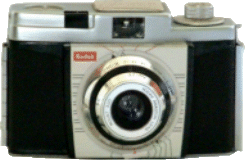
Although it is quite possible to take adequate colour photographs with the Brownie type cameras shown above, in the sixties, manufacturers pushed cameras "designed" for colour photography. This Kodak Colorsnap 35 is an example. It was made in Britain for the British market, but still used the American spelling of colour!
It was rather more advanced than the Brownie 127. It had settings for brightness and cloud conditions (aperture settings, but they were not labelled), focus adjustments and settings for flash. This kind of camera was very popular in the late fifties and throughout the sixties.
There were many different companies marketing this type of camera in the sixties. Amongst the more popular were Agfa, Balda, Ilford and Boots, as well as several Russian makes. These cameras had varying degrees of sophistication and many offered full control over shutter speeds and apertures, but to get the most out of them, you really needed a light meter.
Aldis XT slide projector
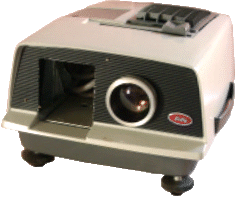
Colour slides really took off in the sixties. Many people bought slide projectors, such as this one, to show their holiday snaps to friends and relations - the 60s' equivalent of the holiday video!
Kodak Instamatic
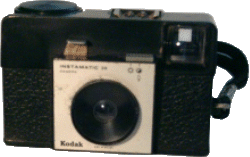
Photography appeared to be getting more complex with colour slides and 35mm - but Kodak continued to make things easier for the photographer who wanted to forget about the technical details and just take pictures. In 1963, they introduced the Instamatic. "Instamatic" mean that the film came in a pre-loaded case and you just opened the back of the camera and slotted it in.
The camera on the right, is an Instamatic 25. It is one of the most basic versions. This camera has a hot shoe for a flash attachment. Later versions took the blue flash cubes - just four shots from one cube - no late sixties or early seventies Christmas would have been complete without one!
Polaroid instant photography
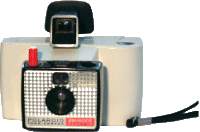
If you really wanted instant pictures in the sixties, you could have them! In 1966, Polaroid launched the Swinger 20 in the UK. This was the first Polaroid camera aimed at the popular end of the market. Priced at £9 19s 6d it was good value compared with the more basic 35mm cameras, which could cost nearly as much. However, the film was expensive - nearly 2s for a single print!
Unlike the other cameras, it had a built-in light meter and needed batteries. However, it was quite simple to operate. You pointed the camera and turned a knob until the word "YES" appeared in the viewfinder instead of "No". This was needed, because Polaroid film was much more sensitive to error. The camera could also only take black and white pictures. Although Polaroid did make colour film, you needed a more expensive camera.
More on the Polaroid Swinger 20.
Japanese SLRs
One of the most significant developments in the fifties and increasingly in the sixties, was the popularity of single lens reflex (SLR) cameras with the professional photographer and the serious amateur. It was also the era when the Japanese took the West by storm. Many well respected names of today first appeared in the UK in this era. Nikon, for example, very quickly gained a reputation for quality. Before the fifties, it was almost unknown as a brand. Many other Japanese names including Canon, Olympus, Minolta and Pentax established themselves in the UK during this era. The Japanese Government did a lot to promote the camera industry in Japan during this time and to ensure that only top quality products were exported.
Pentax
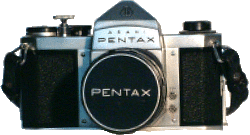
This Pentax S3 of around 1963 is a classic example of a Japanese SLR from the sixties. These cameras are a delight to use and can still be used today. There was only one thing missing - through-the-lens-metering. Pentax was one of the first to introduce this in 1964 with the Spotmatic.


Comments